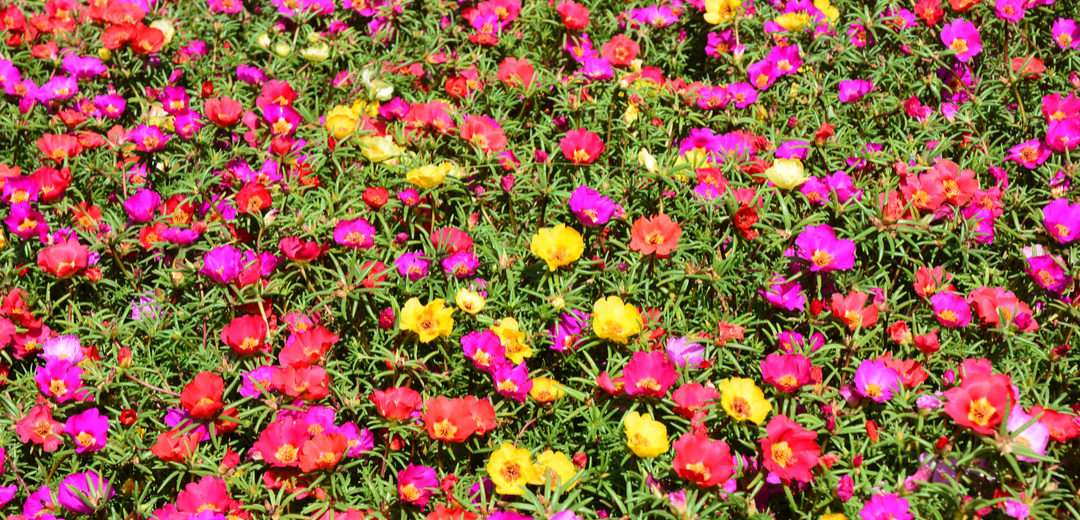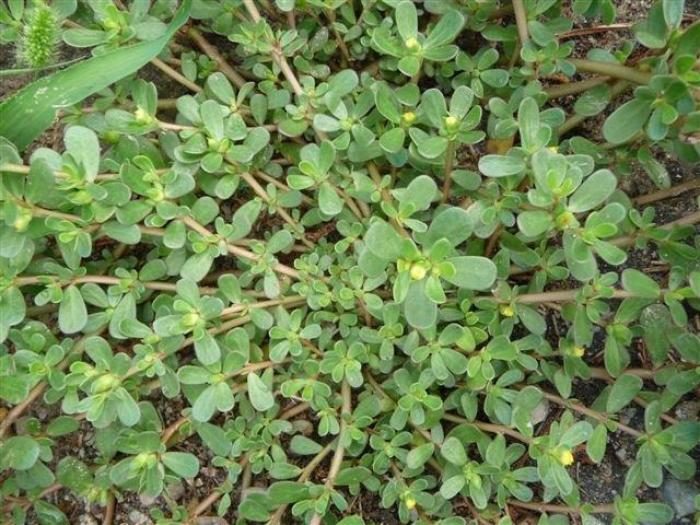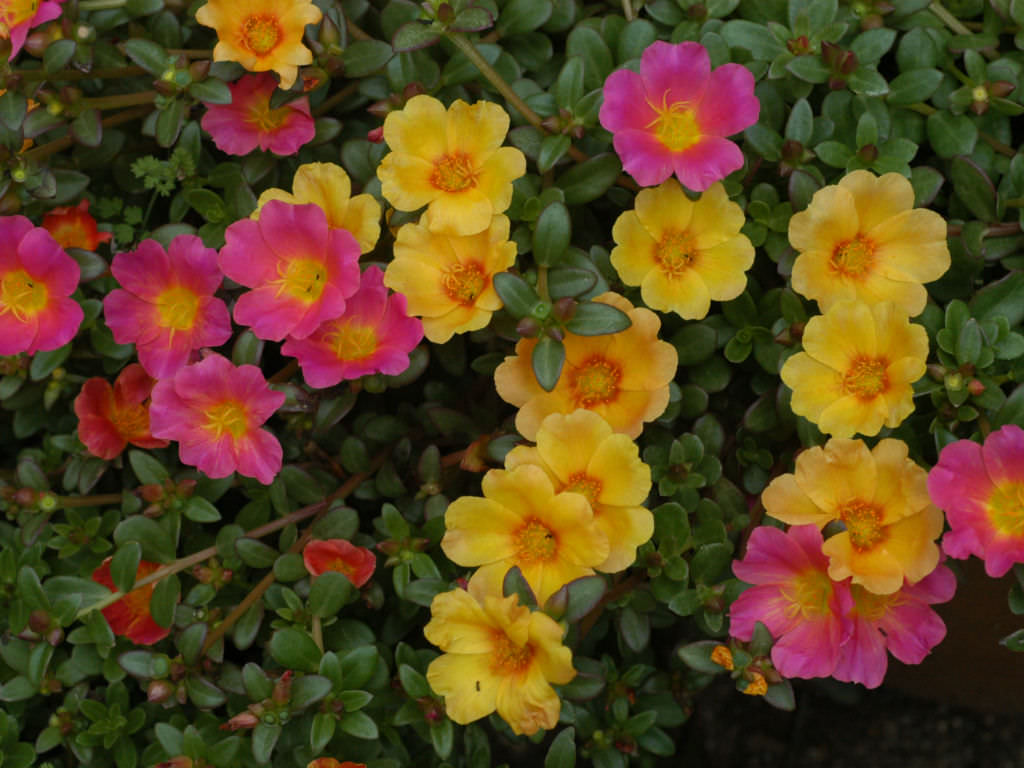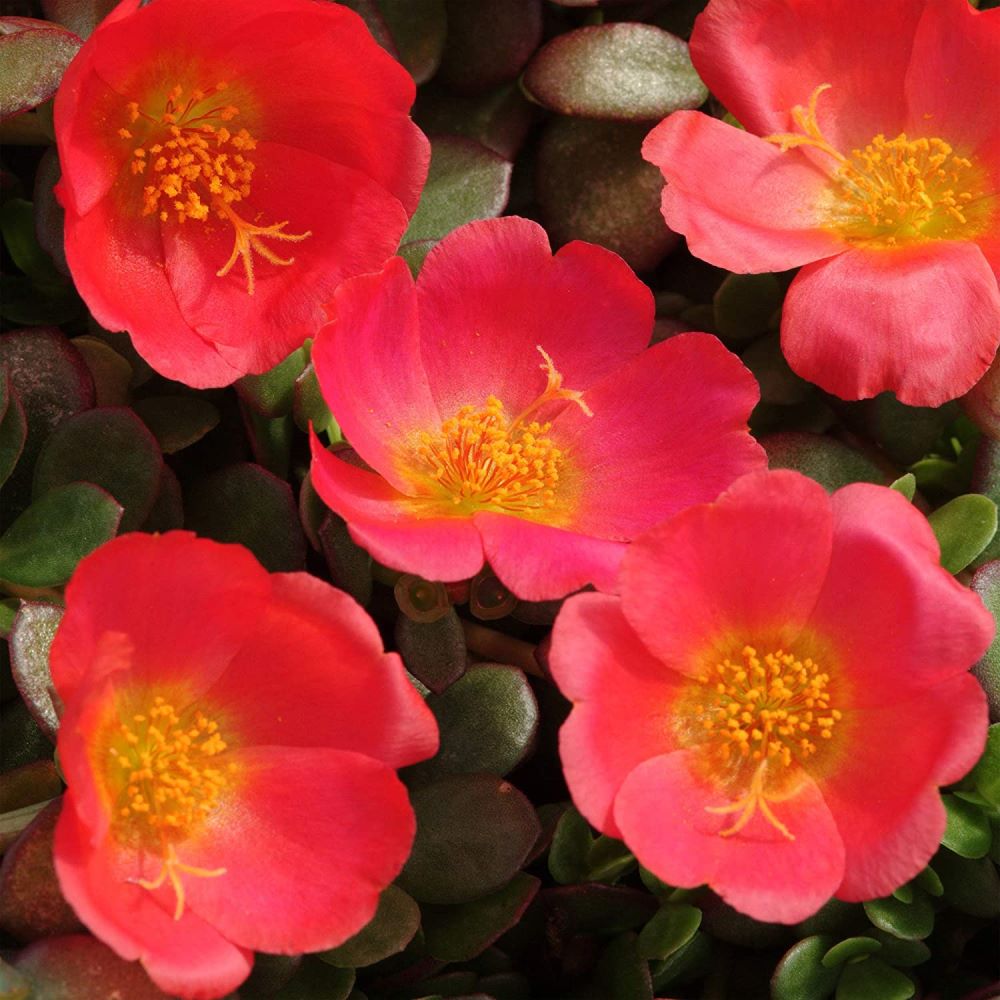
Purslane is a carpet annual plant that attracts, first of all, with its flowers – single, rather large (from 3 to 6 cm in diameter), they are simple, double and semi-double, color – white, orange, yellow, cream, pink, cherry and pinkish red. Flowers are located at the ends of the stem.
Flowering lasts only one day – having blossomed in the morning, by the evening the flower dies off. But due to the fact that new flowers on the purslane, under appropriate conditions, are formed constantly and very much, the decorativeness of the plant does not suffer from this. The flowering period of purslane begins in June and lasts until the first frost.
Purslane is a plant that is very convenient for use in landscape design. It grows well, covering the soil with a green continuous carpet – that is why it is often used as a ground cover plant, especially for open sunny places, on dry soils it generally acts as a substitute for a lawn. It feels good on stony soils, with its help you can get a flower carpet, both on flat slopes and on slopes.
It is used everywhere – in rockeries, on stone walls, in ridges, between slabs, on dry and southern slopes of alpine hills. In a flower garden, it can successfully replace faded Ornithogalum, Muscari, and other small-bulbous plants blooming from the beginning of spring. In a mixborder, purslane is usually planted as a foreground plant, and in arid places as a curb plant.
Due to its unpretentiousness, purslane feels great in the garden or hanging vases, it is well suited for growing on loggias and balconies.
| Plant Type: | Annual herb |
| Native To: | Southeast Asia, southeast Europe |
| Hardiness (USDA Zone): | 5-10 |
| Season: | Summer |
| Exposure: | Full Sun |
| Time to Maturity: | 50 days |
| Spacing: | 8 inches |
| Planting Depth: | 1/2 inch |
| Height: | 12-18 inches |
| Spread: | 12-18 inches |
| Tolerance: | Drought, heat |
| Water Needs: | Low |
| Maintenance: | Low |
| Soil Type: | Average to poor |
| Soil pH: | 5.5-7.5 |
| Soil Drainage: | Well-draining |
| Family: | Portulacaceae |
| Pests & Diseases: | purslane blotchmine sawfly, portulaca leafmining weevil; black stem rot |
| Genus: | Portaluca |
| Species: | oleracea |
Types of Purslane (Portulaca Oleracea)
Despite the fact that about 200 species of purslane are known in nature, only two of its species are grown in culture.

Large-Flowered Purslane (Portulaca Oleracea)
In its natural habitat, this species is perennial, but in our conditions, it is grown exclusively as an annual plant, because, even when sheltered for the winter, it does not tolerate frost. It is a low (up to 20 cm) creeping plant with a strongly branching stem, the leaves are cylindrical in shape, reaching up to 2 cm in diameter. The most popular varieties:
- Scarlet is a low-growing (up to 12 cm) plant with a highly branched stem. Flowers – double, scarlet, up to 5 cm in diameter, flowering lasts from July to mid-October.
- Cherry is a short (up to 12 cm) plant with simple cherry-colored flowers that can reach up to 5 cm in diameter.
- Hybrid “Cream” – double flowers, up to 5 cm in diameter, cream, with more intense color in the middle.
- Slendex – this variety of purslane attracts with its flowers of an unusual, pink-purple hue.
- Sunglo is a variety that has not only the largest flowers but also keeps flowering even on cloudy days.
- Orange – with bright orange flowers, this variety is often used as an ampelous plant.
Garden Purslane (Portulaca Oleracea)

Another name is dandur or flea plant, extremely unpretentious, among most summer residents it is notorious as a difficult-to-remove weed. It is a plant with a fleshy, bare, succulent stem, the shoots have a characteristic crimson pigmentation and can reach up to 60 cm in length, usually, they lie on the ground, only the growing parts are raised. Leaves are fleshy, clawed or oblong-oval, yellowish-green, or green in color.
Flowering lasts in June-September, but has no decorative value – the flowers are inexpressive, very small, yellow.
For medicinal purposes, purslane was used in ancient times, its leaves and shoots are used for vitamins A, E, C, PP, K, as well as easily digestible proteins, carbohydrates, carotene, organic acids, saponins, mineral, and slimy salts.
In folk medicine, purslane is used as a wound healing, anti-inflammatory, and diuretic, it helps to relieve inflammation in the bladder, kidney and liver diseases, arthritis, eye diseases. Drinking purslane juice helps lower blood sugar and cholesterol levels.
In cooking, green, succulent shoots are used, which are cut before flowering. The greens have a slightly sour, refreshing taste with mild and spicy undertones, reminiscent of sorrel or spinach. Purslane is used both for preparing salads and in vegetable dishes, gravies, and sauces for fish and meat dishes. In Transcaucasia and Central Asia, it is pickled and salted, as well as harvested in a dried form.
Purslane: Growing and Care

Growing purslane is quite simple, it is an ideal plant for those who cannot devote a lot of time to caring for the plant. The main thing is to choose the right soil for it. Purslane comes from Brazil and Argentina, so the main condition for its normal development and abundant flowering is the sun, it is a very thermophilic and light-loving plant. There should be a lot of sun because on cloudy days or in a shaded place, the purslane flowers do not open.
With a lack of light, flowering may not start at all, the stem lengthens, the carpet loses its solidity.
The Soil
Sandy, poor soil is best suited for planting purslane – on too “oily” soil, the plant will intensively increase the green mass, but flowering may not occur at all. It is very important that there is no peat in the soil. To adapt the “heavy” soil for planting purslane, you can add charcoal.
Top Dressing
Purslane does not need feeding, it perfectly tolerates poor soils, but fertilization can cause the cessation of flowering.
Watering
Purslane requires frequent watering immediately after transplanting, during the period of active plant growth. As it grows, the frequency of watering decreases. Despite the fact that the fleshy leaves of purslane are able to accumulate water, an adult plant needs periodic watering, on average, once a week, and in very dry summer, once every 3-4 days.
Care
Purslane is very unpretentious, it does not require weeding (most often, you will have to suppress its “aggressive” aspirations, thanks to self-seeding, it is able to cover large areas in a short time, especially vegetable purslane), loosening the soil or pruning.
Diseases and Pests
Purslane is extremely resistant to diseases, the only disease that is quite rare is infection with the fungus Albugo Portulacaceae, the defeat of which is indicated by small specks appearing on the leaves of the purslane. In this case, the stems of plants begin to deform and lose their attractiveness. To get rid of the fungus, the affected parts of the plant are removed, the remaining shoots are treated with any fungicidal preparations containing copper.
Very rarely, thrips can appear on the plant-insect pests that suck the plant sap, which is why silvery specks form on the leaves.
Reproduction of Purslane

The main breeding method for purslane is a seed. Due to the fact that the ripening of the capsules containing the seeds is very uneven, and when ripe, they immediately crack, for harvesting the seeds they are harvested slightly unripe and laid out on paper. And although the seeds remain similar for 2-3 years, it is better to sow them immediately next year.
Since purslane bloom occurs 2-2.5 months after germination, it is sown for seedlings in early March. To do this, up to 1 cm of fine gravel is poured onto the bottom of a small drainage container. The soil is a mixture of garden soil (80%) and sand (20%). An important point – in the presence of peat in the soil, germination will be extremely low up to its complete absence.
The soil is well moistened with thawed (settled) water, the seeds are simply sown from above, after which the container is covered with a film (glass). The first shoots appear in 5-15 days, after which the film is removed. Until the plants get stronger, the soil is moistened with a spray bottle. Purslane is very thermophilic, the minimum temperature for the normal development of seedlings is not less than + 22C, raising the temperature to + 30C improves the development of plants.
Upon reaching the age of one month, when several real leaves appear, the seedlings dive into small (7-8 cm in diameter) pots.
Purslane is planted (planting, the photo is given below, is carried out when the seedlings reach 5 cm in height and the presence of at least 10 leaves) after the end of night frosts. The distance between individual seedlings is 15-20 cm, soon this distance will be quickly filled with a green rug.
In summer, reproduction can be carried out using cuttings – all leaves, except for a few upper ones, are removed from a 5 cm long cutting and planted in prepared soil.






